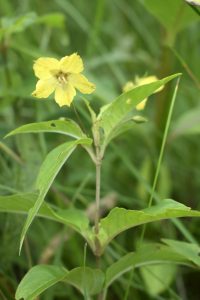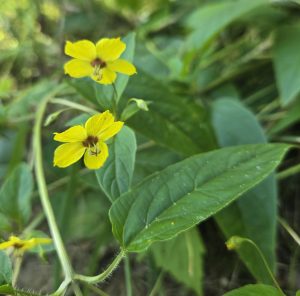Fringed Loosestrife
 Lysimachia ciliata, classified in the Myrsine family, is one of six yellow loosestrife plants native to Minnesota. Pitted against this native species is the potentially invasive, non-native garden loosestrife (Lysimachia vulgaris) with yellow flowerheads that appear more clustered or bunched on the ends of stems. Encroaching but not yet deemed officially a noxious weed, the nonnative version is originally from Europe and may be growing more numerous as it naturalizes out of home gardens and into the landscape. A definitely noxious nonnative that shares a name, called purple loosestrife, has nothing else in common with fringed loosestrife, and is classified in a different family altogether.
Lysimachia ciliata, classified in the Myrsine family, is one of six yellow loosestrife plants native to Minnesota. Pitted against this native species is the potentially invasive, non-native garden loosestrife (Lysimachia vulgaris) with yellow flowerheads that appear more clustered or bunched on the ends of stems. Encroaching but not yet deemed officially a noxious weed, the nonnative version is originally from Europe and may be growing more numerous as it naturalizes out of home gardens and into the landscape. A definitely noxious nonnative that shares a name, called purple loosestrife, has nothing else in common with fringed loosestrife, and is classified in a different family altogether.
 Lysimachia prefer wet soil habitats such as swamps, shorelines of lakes and rivers, wet fields, and moist woods. In contrast to the other yellow-petaled loosestrifes, the leaves of fringed loosestrife are broad — up to 2.5″ across — with hairy leaf stalks leading off the smooth, main stem. That leaf stalk hairiness is where the plant’s ‘fringed’ name comes from and is one way to distinguish this plant from other yellow loosestrifes. The flower’s five, rounded petals end in a sharp tip, sometimes sporting a tint of red in the center. From the center, five cream-colored stamens emerge. A distinguishing characteristic is that the flower heads tend to point downward.
Lysimachia prefer wet soil habitats such as swamps, shorelines of lakes and rivers, wet fields, and moist woods. In contrast to the other yellow-petaled loosestrifes, the leaves of fringed loosestrife are broad — up to 2.5″ across — with hairy leaf stalks leading off the smooth, main stem. That leaf stalk hairiness is where the plant’s ‘fringed’ name comes from and is one way to distinguish this plant from other yellow loosestrifes. The flower’s five, rounded petals end in a sharp tip, sometimes sporting a tint of red in the center. From the center, five cream-colored stamens emerge. A distinguishing characteristic is that the flower heads tend to point downward.
Intriguingly, although they offer edible pollen like most flowers, loosestrife plants do not offer nectar to pollinators. Instead, special glandular hairs at the base of their pistils and stamens produce oil — much loved by the oil-collecting bees in the Macropis genus. The mother bee makes a nutritious ball from the floral oil and pollen she collects from loosestrife flowers (using special brushes on her forelegs to comb the oil, and her other legs to brush in the pollen). She then brings the oil/pollen balls back to her solitary nest and lays her eggs on them to feed the larvae as they develop. The mother bee will also use loosestrife’s floral oils to waterproof her nest which, for these types of bees, is located in the ground. Oil-collecting Macropis bees are becoming quite rare, an excellent reason to include a native species of loosestrife in your garden.

Blooming June into August, look for fringed loosestrife alongside neighbors that also enjoy the same habitat, such as roadside agrimony and marsh hedge nettle, deep into or near the end of their own bloom seasons. Our Little Bass Lake area’s fringed loosestrife starts blooming in mid-July when I have found it growing along the roadside and lakeshore.
